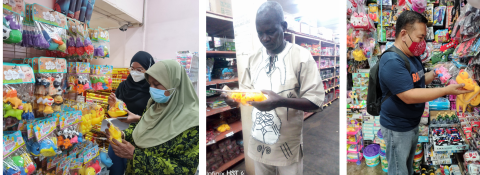Are Your Children’s Toys Hazardous Waste?

High levels of chlorinated paraffins in plastic toys from ten countries
Download the full study below.
Read the press release and find photos from the report here.
Chlorinated paraffins are some of the most hazardous and high production volume chemicals in the world. They are persistent, bioaccumulative, toxic and are released into the environment throughout their life cycle. They are carcinogenic, disrupt the endocrine system, and are neurodevelopmental and reproductive toxicants.
In this study, we analyzed 31 toys purchased in ten countries. The key findings include:
- Chlorinated paraffins are highly toxic chemicals used in many plastics, including in plastic children’s toys. Evidence shows they may cause damage to the liver and kidneys, disrupt the endocrine system, cause cancer, damage developing brains, and pose threats to reproductive health.
- Testing showed that all 31 toys purchased from ten countries contained both short- and medium-chain chlorinated paraffins (SCCPs and MCCPs).
- Several toys contained levels of SCCPs that are so high they could be classified as hazardous waste.
- SCCPs have been globally banned and MCCPs are being evaluated for a global ban, yet testing shows these highly toxic chemicals remain in children’s toys worldwide.
- Evidence shows chlorinated paraffins are released from plastics through their life cycle. Children can be exposed through skin contact, inhalation, dust, and ingestion.
- Studies show that current levels of exposure to chlorinated paraffins may be associated with adverse effects on human health.
- Sampling has found chlorinated paraffins in the environment all over the world, including in remote locations such as the Arctic.
- Evidence shows that since SCCPs have been banned they are being replaced with MCCPs, even though MCCPs are likely to be just as toxic. Rather than regulating chemicals one by one over decades, the results show the importance of restricting chemicals by classes, to avoid substituting one toxic threat with another.
- When SCCPs were banned, exemptions allowed some continued uses, despite the health and environmen- tal risks. The results are a cautionary tale showing that allowing exemptions can result in ongoing toxic threats.
- None of the toys were labeled for the presence of toxic chemicals. The results show the importance of labeling and traceability throughout the plastics life cycle.
These results demonstrate that current gaps in the regulation of toxic chemicals are exposing children to some of the most hazardous chemicals in the world. The results also:
1. highlight the importance of regulating classes of chemicals to prevent replacing one toxic chemical with another (so-called “regrettable” substitutions);
2. demonstrate the harm of allowing exemptions for continued use of toxic chemicals; and
3. show the importance of transparency and traceability of chemicals used in plastics.
| Attachment | Size |
|---|---|
| 8.99 MB |
